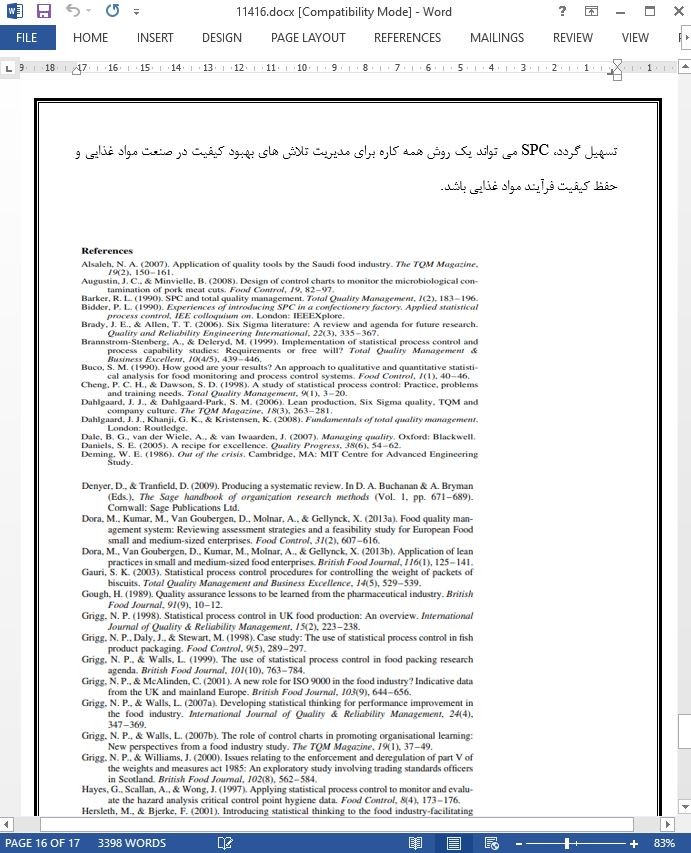
مرور نظام مند اجرای کنترل فرایند آماری در صنعت تولید مواد غذایی
این مقاله یک بررسی سیستماتیک از ادبیات موضوع در اجرای آماری کنترل فرآیند (SPC) در صنایع غذایی است. با استفاده از جستجوهای سیستماتیک در سه دهه از نشریات، 41 مقاله مجلات برای بررسی انتخاب شدند. یافته های کلیدی از بررسی شامل انگیزه های: کاهش نواقص محصول و پیروی از(منافع) قانون و مقررات مواد غذایی؛ موانع: مقاومت بالا در برابر تغییر و عدم دانش آماری کافی؛ و (محدودیت) فقدان تفکر آماری و کمبود دستورالعمل های پیاده سازیSPC است. یافته های بیشتر غلبه انتشارات ایالات متحده آمریکا و انگلستان در این موضوع را مشخص می کند. جهت تحقیقات آینده در مورد مسائل اجرای SPC و همچنین یک مرجع آماده از ادبیات موضوع SPC در صنعت تولید مواد غذایی نیز بحث شده است.
1. مقدمه
رقابت های جهانی شدید در کسب و کار فعلی منجر به محبوبیت رو به رشد شیوه های بهبود مستمر شده است. با وجود اینکه صنایع غذایی به عنوان بزرگترین صنعت در انگلستان تعیین شده است، عملکرد آن (بر اساس ارزیابی انجام بر اساس معیارهای مدل اروپایی تعالی کسب و کار) پشت سر سایر صنایع مانند خودرو، هوا فضا، و بیمه قرار دارد (دورا، ون گوبرگن، کومار ، مولنار، و گلینک، 2013b؛ مان، ادبانجو، و کهو، 1999). کیفیت مواد غذایی تنها به خود محصول مربوط نیست، بلکه به عوامل پروسه های تولید نیز مرتبط است (اور، 1999). علاوه بر این، کنترل کیفیت (QC)، که یک فعالیت بسیار مهم در صنعت تولید مواد غذایی است، که معمولا توسط بازرسی کیفیت محصولات نهایی انجام می شود، مسلما با شکست مواجه می شود و برای حمایت از تلاش بهبود مستمر بی اثر می-شود (پایوا 2013).
6. جهت تحقیقات آینده
این دیدگاه ادبیات موضوع جامع بینش عملی را به سمت اجرای SPC در صنایع غذایی ارائه می دهد. استدلالی که توسط نویسندگان و مطالعات مختلف تا به امروز ارائه شده است مزایا و محدودیت های مرتبط با تصویب SPC در صنعت مواد غذایی را مشخص می کنند. یکی از یافته های مهم از تجزیه و تحلیل تمرکز تجربی ارزشمندی را در جنبه های فنی نمودارهای کنترل برجسته می کند.
This paper is a systematic review of the literature on statistical process control (SPC) implementation in the food industry. Using systematic searches across three decades of publications, 41 journal articles were selected for the review. Key findings of the review include motivations: to reduce product defects and to follow the food law and regulations (benefits); barriers: high resistance to change and lack of sufficient statistical knowledge; and (limitations) an absence of statistical thinking and a dearth of SPC implementation guidelines. Further findings highlight the predominance of publications from the USA and the UK within this topic. Future research directions concerning SPC implementation issues as well as a ready reference of the SPC literature in the food manufacturing industry are also discussed.
1. Introduction
The fierce global competition in current businesses contributes to the growing popularity of continuous improvement practices. Despite being designated as the largest industry in the UK, the food industry’s performance (based on an assessment conducted against the European Business Excellence Model criteria) is lagging behind other industries such as the automotive, aerospace, and insurance (Dora, Van Goubergen, Kumar, Molnar, & Gellynck, 2013b; Mann, Adebanjo, & Kehoe, 1999). Food quality is not only related to the product alone, but also to the factors in production processes (Orr, 1999). Furthermore, quality control (QC), which is a crucial activity in the food manufacturing industry, which is commonly carried out by inspecting quality of final products, arguably fails and is ineffective to support continuous improvement efforts (Paiva, 2013).
7. Conclusions
The conclusions are based on the analysis of 41 articles concerning SPC implementation in the food industry published from 1980 to 2014. In particular, the trend implies that research and publications within this topic are dominated by studies from the UK and the USA. Generally, the review depicted that in the food industry, SPC was applied not only for QC and QI, but also for quality assurance purposes.
1. مقدمه
2. روش تحقیق
3. روند انتشار: کشورها و رشد
4. یکپارچه سازی SPC با دیگر برنامه های کیفی
5. نتایج و بحث
5.1. انگیزه
5.2. مزایا
5.3. موانع
5.4. محدودیت ها
6. جهت تحقیقات آینده
7. نتیجه گیری
1. Introduction
2. Methodology
3. Publication trends: countries and growth
4. Integration of SPC with other quality programmes
5. Results and discussion
5.1. Motivations
5.2. Benefits
5.3. Barriers
5.4. Limitations
6. Future research directions
7. Conclusions
- اصل مقاله انگلیسی با فرمت ورد (word) با قابلیت ویرایش
- ترجمه فارسی مقاله با فرمت ورد (word) با قابلیت ویرایش، بدون آرم سایت ای ترجمه
- ترجمه فارسی مقاله با فرمت pdf، بدون آرم سایت ای ترجمه



